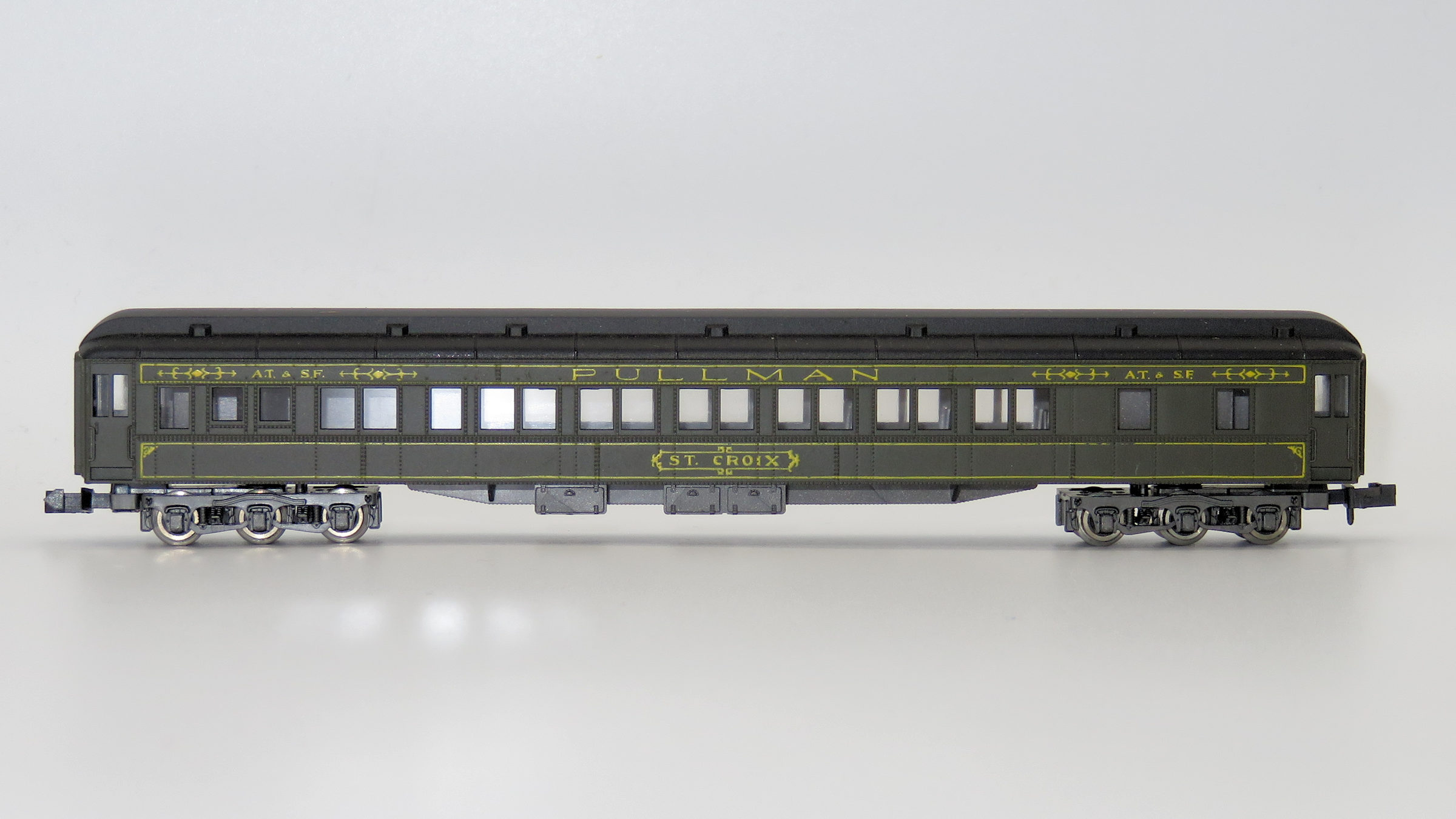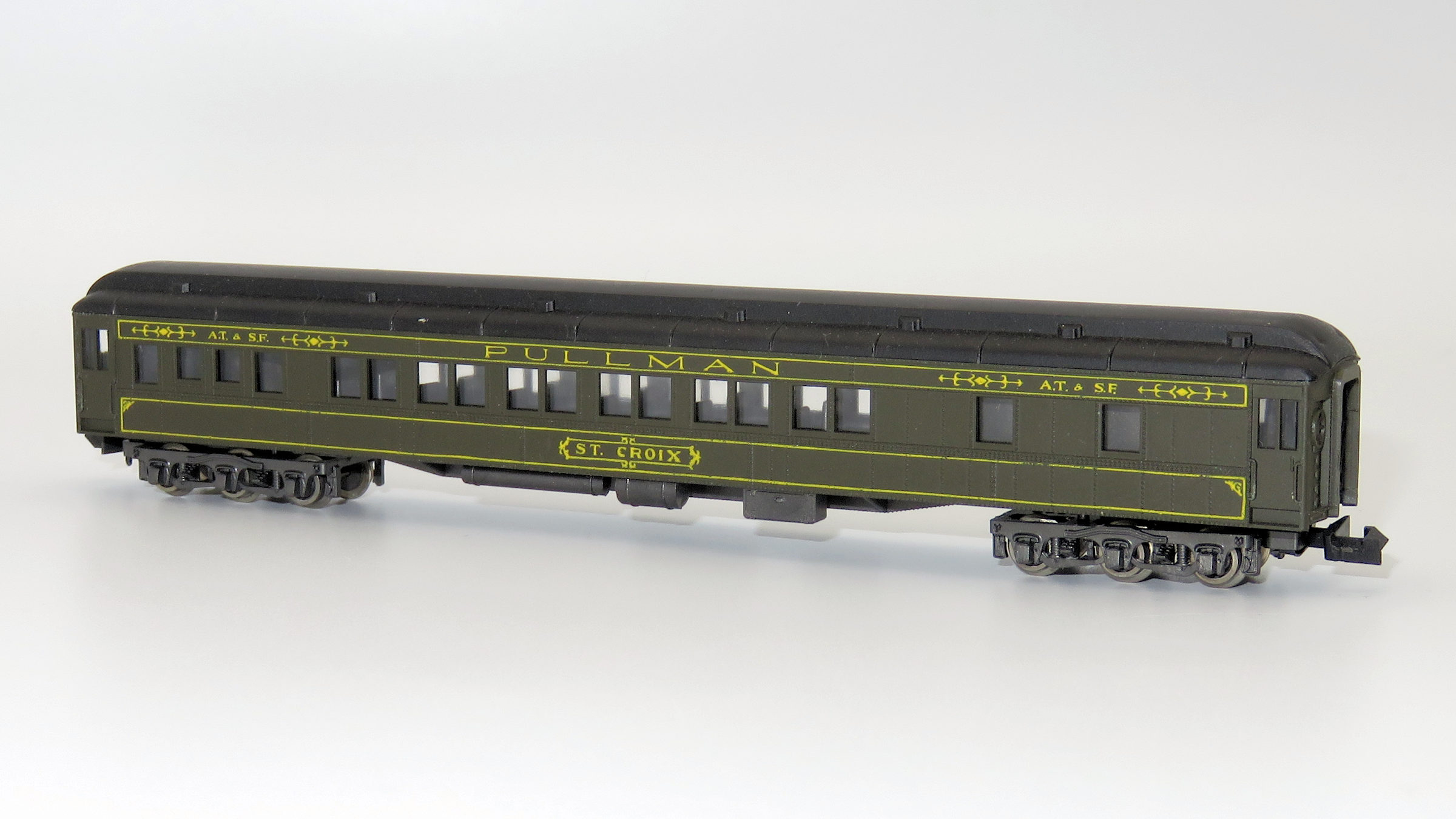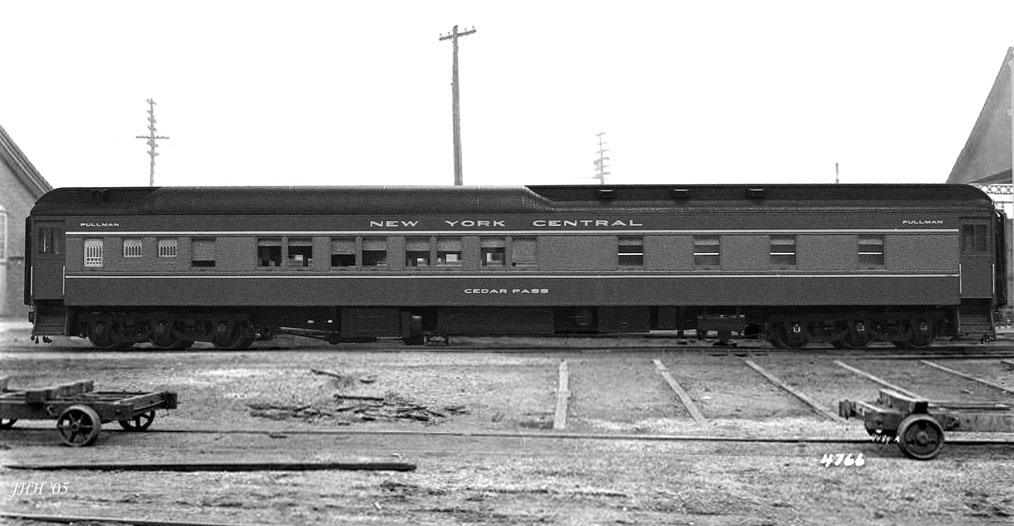Model Information: Introduced in 1967 as Atlas-Rivarossi. Underframe marked Atlas. Sold under the same stock number with Atlas or Rivarossi brand until 1975.
After 1976, sold only as Rivarossi, with new Rivarossi stock numbers and underframe marked Rivarossi. Some boxes from the transition time can have both Atlas and the new Rivarossi stock numbers affixed on it.
This body style was then used by Con-Cor after Atlas stopped selling it.
The model is based on a 12-1 Pullman Sleeper.
After 1976, sold only as Rivarossi, with new Rivarossi stock numbers and underframe marked Rivarossi. Some boxes from the transition time can have both Atlas and the new Rivarossi stock numbers affixed on it.
This body style was then used by Con-Cor after Atlas stopped selling it.
The model is based on a 12-1 Pullman Sleeper.
Prototype History: Pullman was the leading producer of heavyweight coaches during the 1st half of the twentieth century. They were known for the quality and luxury of the passenger cars. The observation car was a common sight on heavyweight consists during 1920s and 1930s.
Sleeping, parlor and lounge cars of riveted carbon steel body-frame construction were built, owned and operated by the Pullman Company. These cars were better known by the name "Heavyweight Cars." Between March 1907 and February 1931 there were 8011 cars built.
The 12-1-1 and 10-1-2 cars had four sections, the rest room, vestibule and all rooms removed from the same end. The rest room was moved into the vestibule and five double bedrooms (A,B,C,D,& E) were constructed at that end. Although compartments and drawing rooms were becoming increasingly popular with travelers in the 1920s, Pullman (and most railroads) still favored open section cars, which carried more passengers and generated more revenue per trip. As a result, the 10-1-2 became one of Pullman's most common heavyweight cars, equipped with 10 open sections, two compartments and a single drawing room. Cars built to Pullman Plan #3585, Lot #4728 in late 1923, this configuration is typical of cars modernized with air conditioning in the 1930s, some of which remained in operation into the 1960s.
Sleeping, parlor and lounge cars of riveted carbon steel body-frame construction were built, owned and operated by the Pullman Company. These cars were better known by the name "Heavyweight Cars." Between March 1907 and February 1931 there were 8011 cars built.
The 12-1-1 and 10-1-2 cars had four sections, the rest room, vestibule and all rooms removed from the same end. The rest room was moved into the vestibule and five double bedrooms (A,B,C,D,& E) were constructed at that end. Although compartments and drawing rooms were becoming increasingly popular with travelers in the 1920s, Pullman (and most railroads) still favored open section cars, which carried more passengers and generated more revenue per trip. As a result, the 10-1-2 became one of Pullman's most common heavyweight cars, equipped with 10 open sections, two compartments and a single drawing room. Cars built to Pullman Plan #3585, Lot #4728 in late 1923, this configuration is typical of cars modernized with air conditioning in the 1930s, some of which remained in operation into the 1960s.
Road Name History: The Atchison, Topeka and Santa Fe Railway (reporting mark ATSF), often abbreviated as Santa Fe or AT&SF, was one of the larger railroads in the United States. Chartered in February 1859, the railroad reached the Kansas-Colorado border in 1873 and Pueblo, Colorado, in 1876. To create a demand for its services, the railroad set up real estate offices and sold farm land from the land grants that it was awarded by Congress. Despite the name, its main line never served Santa Fe, New Mexico, as the terrain was too difficult; the town ultimately was reached by a branch line from Lamy.
The Santa Fe was a pioneer in intermodal freight transport, an enterprise that (at one time or another) included a tugboat fleet and an airline (the short-lived Santa Fe Skyway). Its bus line extended passenger transportation to areas not accessible by rail, and ferryboats on the San Francisco Bay allowed travelers to complete their westward journeys to the Pacific Ocean. The ATSF was the subject of a popular song, Harry Warren & Johnny Mercer's "On the Atchison, Topeka and the Santa Fe", written for the film, The Harvey Girls (1946).
The railroad officially ceased operations on December 31, 1996, when it merged with the Burlington Northern Railroad to form the Burlington Northern & Santa Fe Railway.
Read more on Wikipedia.
The Santa Fe was a pioneer in intermodal freight transport, an enterprise that (at one time or another) included a tugboat fleet and an airline (the short-lived Santa Fe Skyway). Its bus line extended passenger transportation to areas not accessible by rail, and ferryboats on the San Francisco Bay allowed travelers to complete their westward journeys to the Pacific Ocean. The ATSF was the subject of a popular song, Harry Warren & Johnny Mercer's "On the Atchison, Topeka and the Santa Fe", written for the film, The Harvey Girls (1946).
The railroad officially ceased operations on December 31, 1996, when it merged with the Burlington Northern Railroad to form the Burlington Northern & Santa Fe Railway.
Read more on Wikipedia.
Brand/Importer Information: Rivarossi was one of the world's most famous Italian manufacturers of model railways. Rivarossi was founded in 1945 by Alessandro Rossi with Antonio Riva. In the 1990s Rivarossi acquired Lima (1992), Arnold (1995) and Jouef (1996). In 2003, after several years of managerial and financial vicissitudes, Rivarossi ceased its activities.
In 2004 Hornby Railways plc acquired assets from Rivarossi, in particular the brands Arnold, Jouef, Rivarossi and Lima. Since 2006 products are sold again under these brand names, with product manufactured in China. For complete information, visit Rivarossi Memory (mostly in Italian with some sections available in English).
In 2004 Hornby Railways plc acquired assets from Rivarossi, in particular the brands Arnold, Jouef, Rivarossi and Lima. Since 2006 products are sold again under these brand names, with product manufactured in China. For complete information, visit Rivarossi Memory (mostly in Italian with some sections available in English).
Item created by: klausnahr on 2020-10-24 06:15:29. Last edited by Alain LM on 2020-11-01 04:39:21
If you see errors or missing data in this entry, please feel free to log in and edit it. Anyone with a Gmail account can log in instantly.
If you see errors or missing data in this entry, please feel free to log in and edit it. Anyone with a Gmail account can log in instantly.












